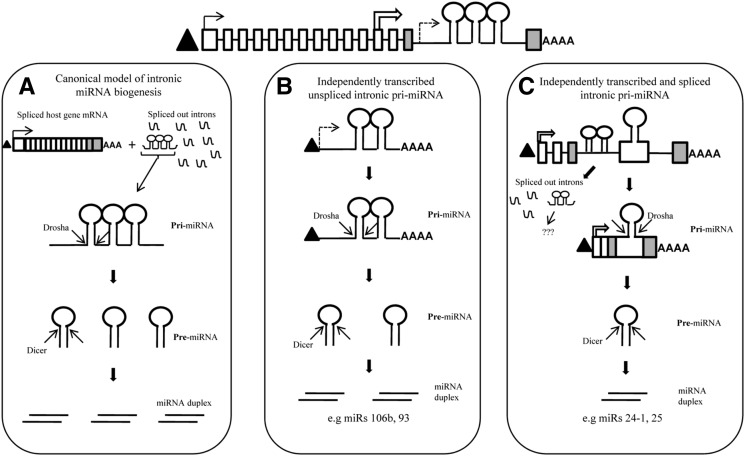FIGURE 6.
Alternative model of intronic miRNA biogenesis. The schematic on top shows the schematic representation of the genomic locus of a hypothetical host gene which harbors a cluster of three miRNAs in one of its introns. The solid arrow represents the TSS of this host gene. Triangle (▴) represents 5′ 7-methyl guanosine cap, while “AAAA” represents the 3′ poly(A) tail. The exons flanking the miRNA-hosting intron are shaded gray. (A) The canonical model of intronic miRNA biogenesis wherein splicing of the host gene results in release of the miRNA-harboring intron. The pre-miRNAs in this intron are then sequentially processed by Drosha and Dicer (represented by convergent arrows) to release the mature miRNAs. (B,C) The alternative model of biogenesis by independent transcription and alternative splicing as deduced from this study. (B) An independently transcribed unspliced pri-miRNA harboring two intronic miRNAs. This pri-miRNA is transcribed from a unique TSS (dashed arrow) within the host gene intron as observed in the case of PRI 106b/93. The pri-miRNA is then acted upon by Drosha and Dicer to release the mature miRNAs. (C) An independently transcribed spliced pri-miRNA. This pri-miRNA is transcribed from a unique TSS (open arrow) within the host gene as observed in the case of PRI 24. The pre-miRNA of one of the intronic miRNAs is included in this spliced pri-miRNA sequence as a result of alternative splicing within the miRNA-harboring intron as observed in PRI 24, ALT SPLICE 25, and ALT SPLICE 93. Further processing of this pri-miRNA releases the mature miRNA. It is unclear at the present moment whether the spliced out intron harboring the two other members of the miRNA cluster would be processed by Drosha (represented by “???”).

